My child’s texture
Limbs longer always than I last remember
Coiled with youth
Springy and joyful like undercooked pasta
Pleases me.
author . artist . singer
My child’s texture
Limbs longer always than I last remember
Coiled with youth
Springy and joyful like undercooked pasta
Pleases me.
This catastrophic breakup song is inspired in part by NK Jemisin’s scfifi/fantasy Broken Earth series. Loved it! Also, Mark’s got a skeletal backing track already, so this one might make it into full song form.
This is the last time we almost kiss
Before the tension all goes slack
A final moment of ignorant bliss
Before the test results get back
CHORUS
Accidents or deliberate stings
Falls and breaks, painful things
The passing of time isn’t always benign
Irrevocable
This is the last time the peace talks falter
Before we release the bomb
And it’s the last time we enjoy the spring rain
Before the storm is the calm
CHORUS
BRIDGE
That crack in the earth will never close again
The end’s passed by already.
What you feel now are the aftershocks
Inevitability
CHORUS
This is the last time I’ll speak with you
Before everything we say is wrong
It’s the last time we’ll play this tune
Before the end of the song
(I’m doing the autobiographical water chapters all out of order. This is 5 or 6.)
We moved from West Point to Buffalo, NY between my Sophomore and Junior years in high school. I finished out my last two years at Calasanctius School for the Gifted. It was tiny, run by Hungarian Piarist priests, and full of brilliant misfits. My graduating class had eight people in it.
There were many amazing things about Calasanctius, including a tradition of reading and discussing original texts which served me well later at the University of Chicago. Another was the field trips. These weren’t a simple day trip to the museum. No. These were week-long sojourns with long stints in the one bus that belonged to the school, punctuated by overnights in campgrounds in the middle of nowhere.
This resulted in many formative, unsupervised moments that make me cringe as a parent, in retrospect.
We were at one of those campgrounds somewhat late in the season. There was a lake, out of sight of our tents, over a slope. There were no docks or boats, at least not then, and it was too cold for swimming.
That didn’t stop me, though, and I was determined to go in. The boy and girl I was with were not so enthusiastic. The boy, averting his eyes, set about making a campfire. The girl happened to be wearing shorts and waded in with me, whereas I stripped down to my underwear and jumped right in.
Okay, it was a little too cold, and it didn’t get deep for a long way. I persisted, though, staggering my way carefully over slippery rocks. It was some distance from shore when it was finally deep enough I could crouch in the brisk water and count myself as actually /in/ the lake.
It was rather more cold and uncomfortable than I had imagined when I had decided to make my way out there. I was just considering the treacherous walk back when the catcalling started from the other side of this, the narrow end of the lake. I couldn’t see who was yelling, since there were trees right up to the edge of the water, and I had taken my glasses off, but I could very clearly hear the suggestion that I perform a certain lewd act upon the speaker, and recognized the voice of a fellow student who was in the year above me (one who had been described by another student, a female friend, as a walking hard-on). There was chuckling, in several voices. He wasn’t alone.
I suppose I should have felt embarrassed, or threatened, or excruciatingly vulnerable in that moment, blind, cold, unclothed. Young. Female.
But I didn’t. And rather than duck back into the frigid water, or try to cover myself, or dash myself against the slick rocks in an attempt to flee, I stood there and shouted back, “What?” still unable to see where the speaker was.
The lewd suggestion was repeated, louder.
I shook my head as if confused and yelled back, “I’m sorry, I’m having trouble hearing you.”
He repeated it again, louder, sounding frustrated, incredulous.
I put my hand up to my ear as if listening hard and said, “Still not sure what you said.”
He screamed it, his voice cracking finally, and I could hear his cohorts laughing at him out loud now. It was obvious to them I heard him just fine the first time.
I shrugged and shook my head. There was muffled cursing and laughing as the group of boys moved away, and I went, calmly and carefully, back to my own group at the waiting campfire on my side of the lake.
It was uncomfortable, trying to pull my clothes over wet, clammy skin, and the campfire wasn’t really fiery enough to provide much heat, so I sat there blue and chattering.
But that was okay.
I was warmed by an inner sense of justice served.
In this modern age, there would be a digital record of the event, no doubt uploaded onto the internet before I even stepped out of the lake, and it might have haunted me through the rest of high school in a very different way. But there was no video. No record but this one.
And nobody ever brought it up with me after, either.
I like to think they were prevented by a new-found fear of watery tarts.
The first water I ever floated in was probably the North Pacific Ocean, off the coast of Hawaii. My two brothers and I were all born in Honolulu Hospital. Although a military family, we didn’t live on base. We lived in a small house in a local neighborhood, which I only remember in the form of plentiful stories. The local Hawaiians, our neighbors, helped the poor, deserted Army wife raise her three kids while her husband was off in Vietnam. We were born there, so we were dubbed kama’aina (native Hawaiians), although we tended to stand out.
However, even if my first experience with water was something so majestic, so primal, as the ocean, the first time I remember swimming, is in our backyard pool in Alabama.
Our house was on a dirt road, and had a sprawling back yard with a big strawberry patch, a chicken coop, and woods that went on a ways. Summers were hot and dusty, with no air conditioning.
We lived in that pool.
There was no formal education to it, no swim lessons at the Y, we just jumped in and taught ourselves. As Mom puts it, we ‘discovered our natural buoyancy at an early age’. There was adult supervision, sure. Dad, who was a medical officer in the Army by then, but had started out as an engineer, was making and installing concrete tiles in a patio around the pool (which I think was previously surrounded by just more dirt), so he would keep an eye on us as we cavorted.
The pool had a level shallow end, which, after ten feet, sloped down to a deeper end where you could dive.
I would have been four or five when I first started spending all my time in that pool. (Like, all my time. There was a point at which I was spending so much time submerged, that my hair never completely dried, and it was all cut off because of the constant mildew smell.)
I was supposed to stay in the shallow end at first, but there was this one time I didn’t.
Not necessarily on purpose.
I was too close to the edge of the deep end, where the slope began. Having taken one step too far, I found myself in a position where I couldn’t keep my head above water, but I also wasn’t heavy enough to stand on the bottom. My toes would brush the surface, but rather than allowing me purchase enough to scramble back to the safety of the shallow end, it just pushed me further away. My as-yet-insufficiently-discovered buoyancy worked against me.
So I drifted just under the water, my hair (not yet reduced) floating above me in swirling tentacles. Below me, and deep into the mysterious unknown of the deep end, the light, fractured by ripples above, raced around the bottom in schools of glowing, glass fish. It was so pretty.
Reaching for the bottom with my toes was useless, so I stopped doing that. Waving my arms didn’t get my head above water, so I stopped doing that. Realizing that the issue of breathing would have to be addressed in the near future, I focused on that instead.
You can’t breathe water, so despite the growing urge to do so, I didn’t open my mouth to draw it in. I knew that much. Instead, I focused on that urge itself. I experimented with it. I pulled my diaphragm down, as if I were breathing, and let it back up again a few times and found this calmed the urge to inhale somewhat. Was there any reason that wouldn’t work forever? I could only try and see.
And so I hung there, suspended in between, both too high and too low, a state which would resonate throughout the rest of my life, until the whole thing ended in a confusing jumble of pain and broken light.
I was told later that my father saved me from drowning by yanking me out by my hair.
I was convinced at the time that I had almost figured out how to breathe underwater, and he ruined it.
My friend Yolanda Fajardo and her husband are moving to Texas to be closer to her son’s family. When I said I wanted to throw her a going away party, she said absolutely not. Too embarrassing. So I insisted we at least cook something together, since we never had, even after our dozens of conversations about food over the years.
She agreed (Yay!), and today we made ejote (green bean) rellenos, and chaote rellenos. They are the much less common cousins to the chile rellenos which you’ve probably seen/eaten in Mexican restaurants. Originally from El Salvador, Yolanda describes this as an everyday sort of meal, although you would be hard put to find this version when out to eat.
Sarah and I were assistant chefs, and neighbors Sharon, Patty and Steve joined us as well (Patty brought homemade sugar cookies for dessert, and Sharon had to run out and fetch the queso fresca I forgot to get). It was a nice little gathering. Yolanda still has family in town, so hopefully we’ll get together in the future. Maybe we’ll cook yummy things again.
Ingredients:
fresh green beans
chaote squash
tomatoes
onions
queso palena
queso fresca
loroco
eggs
flour
salt
pepper

Slices of chaote boiling.
Peel the chaote and cut into ~1/4-1/3 inch wide slabs, and boil until just soft, al dente. Cook the green beans too (I microwave them for 5′ in a covered glass container, essentially steaming them, but not so much that they turn into mush).
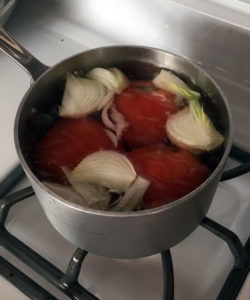 Boil three tomatoes (whole) and a small onion (quartered), together in a small saucepan with just enough water to cover them. This is for the sauce (salsa), that the rellenos sit in later, just before serving. When finished boiling, blend everything together (even the water they boiled in!), and set aside.
Boil three tomatoes (whole) and a small onion (quartered), together in a small saucepan with just enough water to cover them. This is for the sauce (salsa), that the rellenos sit in later, just before serving. When finished boiling, blend everything together (even the water they boiled in!), and set aside.
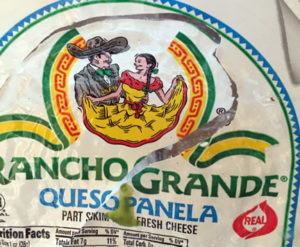 The cheese filling could be mixed with just about anything, according to Yolanda. She likes to include at least one package of the queso palena. But then in addition, you could use another package of the queso palena, or queso fresca (which you can find at regular groceries like Vons, and which we did today), or even mozzarella.
The cheese filling could be mixed with just about anything, according to Yolanda. She likes to include at least one package of the queso palena. But then in addition, you could use another package of the queso palena, or queso fresca (which you can find at regular groceries like Vons, and which we did today), or even mozzarella.
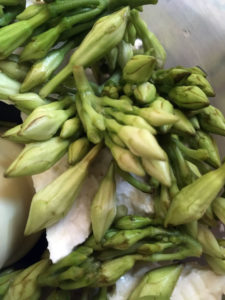
Loroco buds
The key ingredient, though, says Yolanda, if you want the very distinctive El Salvadoran flavor, is the loroco, an edible flower. You’re going to have a hard time finding those fresh anywhere but at an El Salvadoran market. I sampled one before they all went in the food processor with the cheese. It reminded me of okra, but tiny, and with more flavor.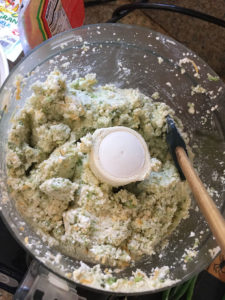
To make the insides of the rellenos, put the green beans in rows of four, close together like a wee green veggie raft. The cheese mixture is patted into a rectangular shape and placed on top of the green beans. Then more green beans are placed on top of the cheese. The idea is to encase the cheese in green beans. The process is similar with the chaote slices, but because the pieces are broader, you can just make sandwiches out of two slices with cheese mix in the middle.
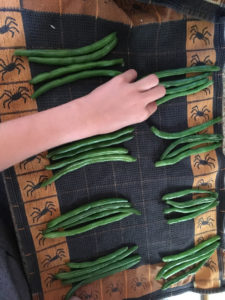
Sarah making green bean rafts.
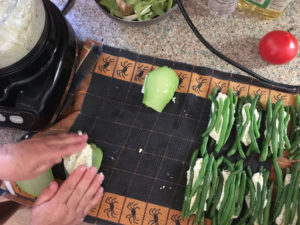
To make the batter, separate 8-9 eggs, and beat the whites with a little salt until very stiff. Then add a spoonful of flour and the yolks, beating again until you have a beautiful, frothy yellow batter.
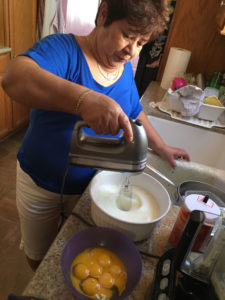
Heat about an inch of vegetable oil in a pan. Two or three at a time, dip the veggie/cheese packets into the batter, and place carefully on the hot oil. Flip when the one side has cooked, then remove to the growing pile of gorgeous golden brown bundles until they’ve all been fried.
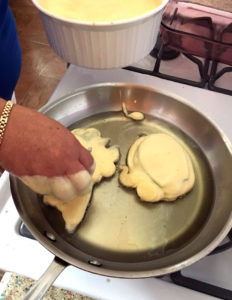
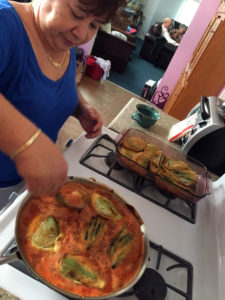 Now pour off most of the oil, leaving enough in the pan to finish the salsa. Add the blended water, onion, and tomato to the remaining hot oil, and cook the salsa down a little bit. If you have some slices of onion left, add those to the salsa now. Then place the rellenos in the pan to heat back up and soak in the sauce a little immediately before serving.
Now pour off most of the oil, leaving enough in the pan to finish the salsa. Add the blended water, onion, and tomato to the remaining hot oil, and cook the salsa down a little bit. If you have some slices of onion left, add those to the salsa now. Then place the rellenos in the pan to heat back up and soak in the sauce a little immediately before serving.
So yummy.
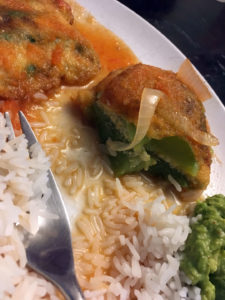
Good luck on your move Yolanda! See you next time!
Alas Uncanny Magazine did not find this to be a good fit with their Disabled People Destroy Science Fiction issue…
Bodies. When you own a healthy body, it’s invisible to you most of the time. You don’t have to think about grabbing a cup of tea. You desire tea, and find the cup at your lips. Effortlessly. Invisibly.
I lost my left shoulder to cancer, an incredibly rare chondrosarcoma. Through some very talented, innovative, well-nigh unique surgery, I was able to keep the arm and hand. But I now have a (3D printed!) metal hinge in my body (an endoprosthesis!) where the scapula used to be. All the subtle, useful bits, like the rotator cuff and half the clavicle, were removed because they were too close to the tumor. Muscles that remained, going as far down as my waist on that side, were pulled up from their normal places and wrapped around the endoprosthesis like a burrito to attach it firmly to my torso. I can’t use the prosthesis to raise my arm, or extend it, or any other shoulderly things, but it holds my arm on. So, although I had to prop my computer in my lap (because I can’t keep my left arm at table level under its own power), and arrange the pillows just so, I have typed this just fine with two hands. I can still write.
I’ve mostly adapted. It’s been exactly a year since the surgery, and I find I can figure out how to do most things. Although some of them I choose not to do in front of people because they require strange contortions and take three times as long as they used to. Some things are just beyond me. What remains of the left arm isn’t rated for anything heavier than 5 pounds.
I stare wistfully at heavy boxes on high shelves.
(In truth, if no one is looking, I will reach up to the elusive box with my right hand, and inch it off the shelf by wriggling my fingers beneath it. Back and forth. Then, when it’s almost over-balanced off the edge, I’ll tip it down onto my shoulder, holding it steady with my head. Clasped between my head and arm, I’ll bobble it over to a table and bend down until I can shrug it off and push it away. If it’s not too heavy. Or too fragile. And if I really need it right then, more than I mind the bruises.)
My goal is for my body to be invisible to me again. I’m tired of looking at it all the time, figuring out the angles and logistics of making and drinking that cup of tea. I would rather just do it. Effortlessly. Invisibly.
As a writer, I’ve been watching myself go through this recovery process. The desire for a return to invisibility has given me a good hard look at what I was taking for granted before, and I’ve decided the body is an illusion. A persistent, well-maintained illusion, that the brain uses to interact with the outside world. So really, there are two bodies. The meat one and the virtual one. That’s why, when people lose a limb, they can still feel it. The meat one may have changed, but the virtual one hasn’t.
When I was first able to start moving the arm, six weeks after the reconstruction, I would try to do things with both hands, automatically, and the left arm would just fall or flop or unbalance everything. Or not move at all. I would be surprised and frustrated every single time. The inconsistencies between the meat arm and the virtual arm were a constant source of disappointment.
So I mentally disowned the arm entirely. I couldn’t update the virtual arm, so I deleted it. I mentally amputated the arm so I could start over. I was a one-armed person. It cut down on the frustration immensely.
Then I started building it back up. If I had a little extra time and energy, I would ‘allow’ the left hand and arm to try to do things. As I found out what it could accomplish, I would slowly build up the new virtual arm and integrate it more into my daily life.
My physical therapist, I think, is fascinated with it. Every time I go in, there is a new, wide-eyed intern following along.
The therspist says to try to lift the arm. I will never lift the arm again, but I still hold out hope of getting more stability, so I try. He holds it a different way and says, okay try to rotate it outward.
And I try. Really hard. I imagine the arm moving, and I’ll have muscles bunching and pulling all over my body that have nothing whatsoever to do with my arm. Like I’m trying to rotate my left arm with my right big toe. And then something will flash or shudder somewhere in my underarm.
Encouraging, the physical therapist says, “There! Did you feel that? Do it again. Imagine reaching out.”
And the freaked out muscle fiber jumps again. We don’t even know which muscle it used to be, everything’s been so rearranged, but after two weeks of trying to activate it, I can get it to contract smoothly and with more control. Who knows what that little fiber will be capable of in another year?
Mechanically speaking, there’s nothing in my shoulder that resembles a shoulder. But there are dribs and drabs, scraps and scars, chunks of meat, that we are trying to repurpose. As I rebuild the virtual arm, my brain is reaching out through abandoned nerves, finding out what they can do, and rewriting them into new movements, new activities. Some of which never existed in the first place. Because the nature of the joint has changed, it can bend frontward and back, in a sort of flapping motion, a little farther than it used to. Is it useful? I don’t know. But it’s already being worked into the virtual model, because I find myself doing it deliberately when I’m getting dressed, without thinking about it ahead of time.
I drive with one arm now. Sometimes the left hand will help out by stabilizing the steering wheel from where it’s sitting in my lap, but that is all it’s good for. The surprising part about relearning how to drive with just the one arm is its similarity to moving my own body in its new conformation. There were new sequences and pathways that had to be adjusted. Driving used to be effortless. Invisible. It’s becoming so again relatively quickly.
I came to realize that the car was every bit a part of my virtual body as my arm was. I didn’t have to think about the car to drive it. I just had to think about where I wanted to go, and the brain would trigger whatever pathways were necessary to get me there. There’s a virtual car connected to my virtual body.
What else fits that category? The computer keyboard, for one. I don’t think about hitting the keys when I’m typing. I just think about the words I want to have appear on the screen. As I type this, I’m conscious of how my mind has generated that virtual keyboard. I type without looking, because muscle memory tells me that this series of impulses generates an ‘e’, and this series generates an ‘h’. As though each symbol existed in my mind as solidly as my own conception of my limbs and fingers. There are letters attached to my virtual body, right there along with the car.
Maybe, given enough training and expertise, this applies to any tool. When you first start using a new tool, it isn’t a part of you. It’s just your meat body touching things and making them go. But eventually, the virtual body becomes so familiar with the use of the thing, that it incorporates it into itself. The piano. The hammer. The paintbrush. The scalpel. The sword. The fighter plane. The prosthetic leg.
The starship.
Our tool-using monkey brain is so greedy, snatching up new virtual pieces and sticking them to itself our whole lives, a subconscious Katamari Damacy. When we think of it at all, we think of our virtual self as being roughly the shape of our meat self, but the truth of it is that our virtual selves are vast and complex, operating in more than three dimensions, slapped together like Swiss army knives, bristling with skill sets.
I’ve started back at aikido, a martial art. I had trained for about 15 years on and off before the cancer. I find myself back on the mat with very low expectations, and a body much more brittle. I’ve been pleasantly surprised. Rather than destroying one’s opponent with brute force, aikido is about instinctively understanding another person’s movement and balance so well that you can manipulate it with minimal interference. Since I can’t wave my left arm in dramatic arcs anymore, I find myself closing the distance, refining my position, and throwing very surprised attackers with a well-timed shrug. (Thankfully I can still shrug. Without a way to physically manifest my natural cynicism and ambivalence, I fear this essay would have been much more of a diatribe.)
In training, we talk about reframing the interaction between attacker and attacked, uke and nage, as a collaboration rather than a conflict. You are not being attacked so much as ‘given energy’ which you can choose to use as you like. In the context of the virtual body, in aikido, I wonder if it’s a matter of the ever-acquisitive mind reaching out and using other people’s meat bodies as its own tools, however briefly.
I had trouble getting around to writing this at first. I’m still very angry about how my once strong, dependable shoulder has turned into this crumpled thing, so I didn’t want to give it credit for giving me this insight. It hasn’t been punished enough yet for such an intimate and unforgivable betrayal. After all, it tried to kill me. But it turns out I can be sincerely furious and grateful and appreciative at the same time. The damage extends to about a sixth of my meat body, but, I’ve come to realize, when compared to my virtual body, it’s almost insignificant.
It has changed the way things look to me. When I watch my friend’s three-month old baby flail, I’m seeing her learn to use her first tool, her own meat body. The first of many tools.
So now, when I think about fictional humans, either with new, strangely articulated bio-engineered limbs, or high-tech prosthetics, or plugged into whole structures or cities, I no longer wonder if it’s possible for the human mind to adapt to such things. I know it is. The brain, in its mysterious and powerful way, will find its way to it, like water flowing downstream. All it needs is a connection, feedback, and purpose. Whether the connection be as direct as a nerve, or ephemeral as a touch, our minds can use it to extend the virtual body. I theorized about it in stories before. Now I’ve watched it happen, from the inside.
It’s what we do as humans.
The irony will be that when we’ve invented and incorporated these new miracles into our virtual bodies, into our very identities, we won’t be able to see them anymore. They’ll be effortless.
Invisible.
Graphic Novels
I love them. I’ve loved them since college. My roommate’s boyfriend would leave stacks of them when he came to visit. That’s how I first was introduced to Neil Gaiman’s Sandman, and it was all over after that. My roommate didn’t even read them, but I convinced her not to tell her boyfriend, so every time he came by, he would bring a fresh pile and remove the old.
That was over twenty years ago, but I still devour graphic novels hungrily.
I went to my first writer’s conference last month, World Fantasy in San Antonio, November 2-5. I went because that same roommate, Mary Anne Mohanraj, now an accomplished author, said, “You should go. It’ll be fun. I’ll show you around.” Which she did, and it was great. But we struggled with how she would introduce me. I’ve been writing for years, but in secret. I have five complete NaNoWriMo novels that maybe only two people have ever read. Nothing published. It was easier to show people my art. So I was introduced as her college roommate who has been writing in secret for years and is a fabulous artist, look at these pieces she has online. And then friends of hers would see me elsewhere in the conference and introduce me to their friends as a fabulous artist, really you should see her stuff. The writer part got dropped because there wasn’t a publication to hang it on.
Which is fine. It was great meeting editors and publishers and fellow writers. I wasn’t there so much to sell myself (yet) as to find out what kind of product I am.
One of the panels was ‘Artist/Authors’. These were people who had started out as artists illustrating other people’s books, but decided that they had their own stories to tell.
I had illustrated a children’s book with a fellow parent, Demery Matthews, whom I met through my kid’s school. It was something I offered for a school fundraiser: I would develop a character and do a few black-and-white images for someone’s story. Demery, an architect (whom I strongly recommend for all your building needs), had this story she had written for her boys years ago. So I did a few illustrations and we loved them and did a Kickstarter for it and distributed it in glorious full color to a bunch of family and friends. You can buy a copy on Amazon if you like, Captain Devin and His Little Red Boat. It’s fun.
I’m glad I did it. It’s cute, and now I know I can. It might never have happened if I didn’t have a partner. But I have my own drawer full of stories, and I felt a little bit as though I had betrayed them.
And it’s like panelist Jeffrey Alan Love said, “Illustrating other people’s work is like being in a cover band.” Not that there aren’t really good cover bands out there, but it’s not the same as being the sole author of your own work.
The Artist/Author: A New Wave of Storytellers panel was moderated by Irene Gallo, and populated by Kathleen Jennings, John Picacio Moteria, Jeffrey Alan Love, and Gregory Manchess.
John Picacio Moteria was doing a series of illustrations for a card game, the Loteria Grande, using fantasy characters, which was based on a Mexican game where you had to get so many in a row (and here I had a bit of a twinge over how much it sounded like a project I had just started with my own friends). His evolution toward author began when he realized he was weaving background stories in his head for all the characters in the illustrations, and that they were linked in a common world, a running narrative. So, instead of just a card game, it became a story, with a card game on the side. It’s very pretty. I plan on buying it when it comes out. My favorite line of his from the panel is about when he realized the images were becoming more nuanced and connected: they became “more eye protein than eye candy.”
Gregory Manchess, who does giant oil paintings with lots of palletknife-work, is not your typical graphic novel artist. But he too, after a career of being commissioned for numerous covers, decided he had his own stories to tell. I bought the book, Above the Timberline. It’s gorgeous. There’s text in it, but there’s so much story in the images themselves that the text is almost a distraction. Or the words serve to slow down the observer enough to appreciate the images more. When I started reading the book, after overcoming my initial awe of the style, I began to wonder if it was too ponderous. It wasn’t the clean pen-and-ink I was used to in a graphic novel. But then I remembered my own advice when approaching new art, to ditch my expectations and shut up. Look and listen first.
Then I was able to notice things. As ‘realistic’ as his subject matter and composition were, his use of broad strokes and the pallet knife frequently suggested details rather than explicitly representing them. I really appreciate that in art. It engages the observer’s brain to fill in the details and appeals to a subconscious curiosity. His snowy, windy backgrounds and stark, dark figures use extreme contrast to create drama. even in still scenes. The depth of his landscapes is cinematic.
Yep. It’s pretty.
If I were in a different emotional place, I might have been intimidated out of ever showing my art again, but next to him on the panel were Jeffrey Alan Love and Kathleen Jennings who were showing their monochromatic prints, or their silhouetted cutouts. And I admired them too.
I am not a masterful oil painter it’s true, but neither are the other artists on the panel, and they’re telling different kinds of stories. And at some point, all these people had to decide what they were, in a creative industry that struggled with finding a category for them. It was good to see bits of my own struggle reflected on the outside. The echo chamber in my head had been getting loud and crowded.
A related panel, New Graphic Novels You Should Be Reading, was similarly awesome. There was a retired staffer from DC Comics moderating, Bob Wayne. He coauthored Time Masters and has written some Wild Cards stuff. There were three panel members. Marta Murvosh is a librarian by day, and contributor to Tales of the Sunrise Lands and Legends of the Mountain State. Carol Burrell (aka Klio) is a writer and editor for Workman Publishing. Finally, Leo Vladimirsky has stories on Boing Boing and in F&SF. They recommended examples of everything from children’s graphic novels to the almost pornographically intense adult tomes. All of which I enjoy, so when I list them below, be warned that they might not all be appropriate for your kids. (After I’ve been through them all, I’ll write up a list that is good for kids, since I’ll be curating for my own 8 year old.)
On the subject of graphic novels for kids, Marta, the librarian, made some good points. Some teachers don’t like their students reading graphic novels, because it’s ‘cheating’, and it keeps them from reading ‘real’ books which could be helping them develop their reading skills. I’ve never understood this. Graphic novels have plenty of text, and the stories aren’t necessarily even all fiction, another prejudice some teachers have. Some of the titles which were recommended are even historical or political nonfiction. Important stories well told. But all these illustrated stories help people develop empathy, just like un-illustrated novels do. They also help students develop visual literacy.
The panel was about new works, but the panelists did mention a few that they credit as the first visual stories they read that got them started down this path. Sandman was mentioned of course, but also Elfquest, the collected Prince Valiant, Wonder Woman (those molemen, amiright?), Dark Knight, and Chandler.
But on to the recommendations. I know my librarian friend (Danica, this is for you) will be interested, but others of you may also want to know what new graphic novels have been generating buzz. Saga, Bitch Planet, and Lumberjanes were all mentioned, of course, but considered maybe not new enough for this panel. (I would recommend all three of those, although only Lumberjanes for kids.)
The List:
Heathen – Natasha Alterici
March – a history of civil rights – Congressman John Lewis
World Without Fish
Trinity: A Graphic History of the First Atomic Bomb
Moon Girl & Devil Dinosaur
Malice in Ovenland
Princess Princess (manga)
Nathan Nails Hazardous Tales
Lowriders in Space – Cathy Camper
The Nameless City Series – Faith Erin Hicks
Climate Changed: A Personal Journey through the Science
Tetris: The Games People Play – Box Brown
Becoming Andy Warhol – Nick Bertozzi
The Midas Flesh – Ryan North
California Dreamin’ – Pénélope Bagieu
Sing No Evil – JP Ahonen
Multiple Warheads – S Clay Wilson
O. M. W. O. T. Terror Assaulter
In the vein of Inktober and NaNoWriMo, here are your guidelines for a Musical December:
1. Do something musical everyday for 15 minutes. Practicing an instrument, singing, recording, writing lyrics, researching your favorite singer/songwriters to create the most amazing playlist ever, etc. This level is for everyone, whether they think of themselves as a musician or not. If you’re wondering whether something counts as musical, then it does.
2. Record something once a week. Could be an original, cover, you, someone else. You don’t have to keep it or share it, but you have to do it.
3. Perform live in front of other people at least once.
4. Write and record an original piece of music.
As a bonus, it would be nice for people to do a piece of winter holiday music to share. (It doesn’t have to be wintery or holiday-themed, if you’re inspired by something else.)
Last month was Inktober. This month is NaNoWriMo, National Novel Writing Month. So, even though I’m not posting everyday, I AM writing everyday. This year’s NaNoWriMo story is about the near future, when, as a part of sustainability and anti-global warming efforts, a new highway system has been developed that uses a tightly engineered moss, instead of asphalt or concrete. Which works great until it starts behaving in independent and inconvenient ways. It takes place in Indiana. (Please remember that, while I’m writing everyday, editing is going to happen some other time.) Some of you might recognize the description of Mt. Baldy…
——
Just out from the the trees, the Indiana Dunes rose, enormous piles of sand, tufted with brave splotches of greenery, blocking the view to Lake Michigan. The roots of the tall, waving grasses battled the wind for the grains of sand. The occasional tree could be seen, impossibly, halfway up the slope.
Conservationists had their own struggle, keeping the locals from trying to snowboard or ski down the slopes, just to see if they could. There was enough damage from people just making their way to the beaches, despite the fact that some days the ‘fresh’ water lake wasn’t so fresh, and swimming less than advisable.
A young couple looking for privacy in the tall grass and sparse bushes might learn quickly not to show too much skin. The water pooled in quiet ways in inlets and marshes nearby so as to support a robust population of mosquitoes. At least, it had. In the last couple of years the blood-suckers just didn’t seem as bad. Whether or not that corresponded to an increase in local teen pregnancies was yet to be studied, but residents were generally appreciative of the change. It was put down no doubt to government efforts to suppress West Nile, and then the Zika virus.
Those cicadas though.
The evenings especially were getting so bad, people had started staying inside their beach houses with the news on loud of an evening. It had gotten so that the constant chirping even drowned out the roar of the high, off-season waves hitting the sand.
Somebody ought to do something about those, they said, when they got together at the neighborhood mailboxes at the entrance to their small beach community, where they would gossip about basketball, the noisy timeshare that never cleared their garbage bins when they were supposed to, and oh yeah. That new road. It wasn’t supposed to extend out this far until next year, but they must have finished it early because there it was.
Like it sprang up overnight.
Still cancer free. (Woo.)
I had the scan before I went to World Fantasy Con in San Antonio, but since I was out of town the next day I had to delay my followup meeting with my oncologist, Dr. Hu, until today, two weeks later. I didn’t think about the scan during the conference. I didn’t think about the scan the following week when I was tromping around San Antonio with Jody and Yo. I didn’t think about the scan while I was waiting at the hospital this morning.
The scan is fine, as I was pretty sure it would be. I didn’t even bother looking at it or taking a picture this time.
Is it possible that I’ve already become that blasé about it?
Dr. Hu asked if I was interested in participating in a study on rare cancers in a project that was part of Joe Biden’s Moonshot initiative. I was very excited about having my tumor sent into space until he explained that no, they just wanted to sequence the genetics of the tumor, then sequence my genetics from a normal tissue sample, and compare the two to isolate any mutations that were associated with the malignancy. The study included a lot of rare tumors, and sounds like a good way of finding targets in cancers that are otherwise too rare on their own to attract much research attention individually.
It also means that there will be a database somewhere with all my genetic info, prime for plundering and abusing in the near dystopian future where our human rights are suborned to actuarial tables of risk and inherent, inescapable fallibilities. This gave me a moment of pause, naturally, until I remembered Mark had recently done 23 & Me and our family was already screwed vis a vis genetic privacy.
Man. How cool would it be to have your tumor on the moon though?
Kristi, the resident working with my oncologist thanked me again for sending the link to the cancer art series I did. She really enjoyed going through it. (As a side note, I also sent the link to my surgeon’s office, but they didn’t even acknowledge that they had received it.) She had emailed me back right away at the time, saying how much she liked it, and did I know they sometimes had patients’ art exhibits in the patient information section in the hospital. She would forward the link to them. Maybe they would be interested in hanging the show.
My visit there today reminded me that I hadn’t heard anything from the office of patient information services, so I asked at the front desk where I might find them, and if anyone was available to talk about my art. Then I whipped out my phone and showed the series to the woman at the front desk.
She got all excited and called the patient information office downstairs, and even walked me down there to introduce me to the woman in charge, Mary, who was a Stage IV breast cancer survivor who never expected to survive, but has been in remission now for five years. She runs the whole thing as a volunteer. They have exhibit space and seating, and a garden outside.
I never knew any of it was there. When I was in the thick of treatment, all my focus was on me, my body. I had to sit just right. I had to breathe just right. I had to concentrate on holding my arm on.
But there it was. It’s kind of nice. We walked in past the current exhibit – small oil paintings, scenes of everyday life, children holding their parents’ hands, guys looking at antique cars, etc.
When I showed Mary my cancer series she said, “Oh. Your work is disease-based. You know it doesn’t have to be. Most of these shows are just the artists’ work. It doesn’t have to be related to your treatment.”
“It is,” I agreed. “Well, it’s kind of a story arc, about the whole treatment experience. The last piece is about me being done with treatment and deciding what kind of person I want to be now.” I showed her Human Again.
“Oh. That’s nice. That’s very powerful.”
“I’m wondering now if you might not want to put it up, though, since, although it’s not graphic per se, it is very focused on the tumor and the treatment. It might be upsetting to people who are still in the middle of it.”
Mary looked thoughtful and said, “You know it’s funny. My mother had breast cancer, too, and because I was next to her through the whole experience, I thought I had the inside track on what patients would like to be exposed to. Then I went through it myself, and I had been completely wrong. No one can tell us what we want to see or think about our own experience. I would like to offer you a show next fall.”
So. It looks like I have a show at Norris Cancer Institute next fall. They have a lot of wall space, so maybe the cancer series will go in one area, and the rest of it will be something else entirely. Like a series of story illustrations. Or a series of illustrated game tiles. Who knows what I’ll have generated in the next ten months?
The thing is, before cancer, I never would have gone downstairs to show them my art. I wouldn’t have wanted to be a bother. Why would I waste some other person’s valuable attention on my stuff?
After cancer, it’s more like, why wouldn’t I? What else were they going to do with that time? Talk about the weather? They might as well look at my art.
Life is short. Whatever hangup I’ve been living with about not wanting to ‘bother’ people – with my art, my music, or my writing, was burned out of me by the chemo. I’m going to create. I’m going to make good things and be unapologetic about them.
And if they turn out not so good on any given attempt, I’m going to be unapologetic about that too.
I’m over it.
© 2026 Margaret Treanor Frey
Theme by Anders Noren — Up ↑